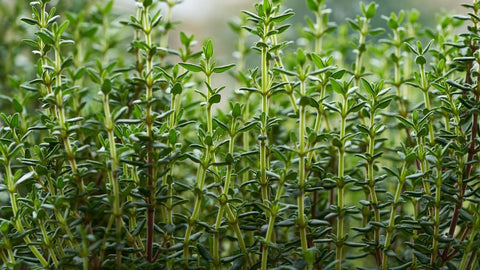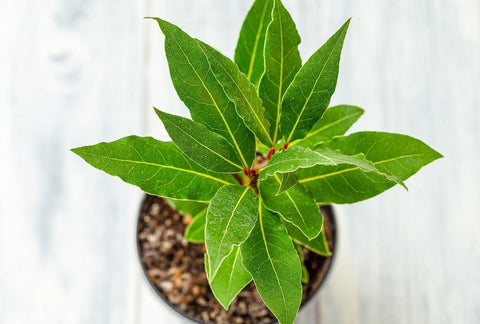Growing Thyme Outdoors: A Complete Guide
Thyme's name was derived from the Greek word thumus, or courage, because in Medieval times knights wore sprigs of thyme on their armor as a sign of courage. In this blog, we’ll be talking about everything related to growing thyme outdoors, from basic facts, supplies, setup, and steps to grow, care for and harvest it, and gardening zones in the US and how they can impact outdoor gardening.
| Plant type | Perennial |
| Family | Lamiaceae |
| Binomial name | Thymus vulgaris |

Timing
Thyme sprouts in 2-3 weeks. It can be harvested from Month 3+ on.

Part sun
Thyme plants need an equivalent of 5+ hours of direct sun [DLI of 15+ mol/m²/day].

Care
Growing thyme outdoors is very beginner-friendly, but it can involve a few more steps compared to growing it indoors. You’ll sprout, thin, prune, and harvest, and maybe try to get rid of pests and other problems from time to time.
TABLE OF CONTENTS
Ways to Grow Thyme | Care and Maintenance for Thyme | Timeline & Steps | Cultivars/Varieties
Ways to Grow Thyme Plant Outdoors
Growing Thyme Outdoors Using Soil
Thyme plants, unlike basil, don’t do well in moist soil conditions. The roots are not accustomed to being too wet and will rot in boggy conditions. On the other hand, if the soil dries out completely the roots will die back and the plant won’t recover. This can catch you off guard because the plant’s not very expressive (its leaves don’t wilt) so it will look fine right up until it dies.
You have two options to choose from when growing thyme outdoors:
- Plant directly onto soil, or
- Use a container - with drainage!
If you prefer planting directly onto soil, you can use potting mixes you can buy from stores or online, or you can also create your own. In this blog, we explained how to create your own potting mix. Just remember that herbs such as thyme thrive more in nutrient-dense soils, so if you don’t have that, you can also look into incorporating plant foods or fertilizers.
We prefer using containers as we have more control over the growth of herbs by using this method. Some herbs can grow aggressively and take over the whole space of garden beds or soil sites. Take note that if you opt for containers, they should have good drainage as herbs such as thyme thrive well in this kind of environment. If you’re not sure what size of pot or container to use for your herbs, check this out.
You can also see the table comparison below about the pros and cons of soil and containers:
| Pros | Cons | |
| Soil (in ground) |
|
|
| Container |
|
|
Other Ways to Grow Thyme Outdoors
You can also use ollas (plant watering spikes/globes) for your containers to help with drainage. Raised beds are a good choice for growing herbs such as thyme outdoors, too.
Best Gardening Zones for Growing Thyme Outdoors
Thyme can be grown in most areas as they are sun-loving, drought-tolerant herbs that can adapt to a range of temperatures, but the most recommended zones are zones 4-9.
You can also check out how to grow thyme indoors if you’d like your thyme plants to be transplanted or grown indoors instead.
Care and Maintenance of Thyme Outdoors
Lighting for Growing Thyme Outdoors
Thyme plants are sun-loving herbs, meaning they need lots of light – but since you’ll be growing them outdoors, you just need to make sure that they would be put in a very bright place that gets at least 5+ hours of direct sunshine.
Right Temperature for Your Outdoor Thyme Plant
Thyme Plants Grow Faster in Warmer Temps
Thyme plants are called “warm-weather crops” and will speed up their metabolism when temperatures are warmer. On the other hand, if things get too hot, they’ll wilt and become prone to disease. Ideal temperatures are around 70°F but anything between 65 and 85°F grows well.
Water and Humidity
Herbs such as thyme thrive on an adequate amount of moisture but can suffer if they’re waterlogged, so make sure to water them just enough, especially if you’re using soil. To avoid your thyme being waterlogged, make sure to use a pot with drainage, or you can also use ollas to help with drainage, as mentioned above.
Nutrients and Fertilizers for Your Outdoor Thyme Plant
Thyme likes to start with nutrients that are equal parts nitrogen, phosphorus, and potassium (with NPK numbers like 10-10-10). For this Balanced Blend, we recommend: Dr. Earth All Purpose
Once they are growing, it’s better to use plant food that is high in nitrogen (with NPK numbers like 10-5-5). For this Herb Blend, we recommend: Joyful Dirt All Purpose
Moving Your Thyme Plant Indoors
As we mentioned above, thyme as a sun-loving, drought-resistant herb, mostly thrives in warm temperatures, so we suggest moving them indoors only when the temperature is too warm or too cold for its liking. To learn more about how to grow your thyme indoors, check this out.
Common Problems with Growing Thyme Outdoors
Pests
As you’ll be growing your thyme outdoors, you need to keep in mind that you might encounter pests such as spider mites and aphids. To learn more about managing these pest problems for thyme, check this educational article from Planet Natural.
Diseases
Growing plants outdoors can bring risks to your plants to also have diseases, such as root rot and blight. There are different solutions for each of these diseases and for you to know more about them, we suggest reading through this helpful article from Gardener’s Path.
Timeline and Steps on How to Grow Thyme Outdoors
Best Setup for Your Thyme Plant Outdoors
Below is the best setup (and a very easy one!) for growing your thyme plants outdoors. You’ll need:
Thyme Planter:
Ceramic Self Watering Planter or pot that is at least 6" / 1 quart. Raised beds and ollas are also great choices.
Soil:
Free-Draining Mix
Plant Food:
At the start: Balanced Blend. This should be equal parts nitrogen, phosphorus, and potassium (with NPK numbers like 10-10-10).
Ongoing: Herb Blend. This should be high in nitrogen (with NPK numbers like 10-5-5).
Starting Your Thyme: Seed vs Cutting vs Nursery Plant
New Thyme plants can be started from seed, propagated from an established plant, or purchased live at many garden centers. When growing thyme, we prefer to sprout from seed or propagate from a stem cutting, as it results in plants that are adapted to your growing conditions and limit the chances that you accidentally bring home pests.
How to Plant Thyme Seeds

Thyme grows quickly from seed. Plant 1 site in a 6" / 1-quart container. In larger containers, space sites 4" apart. For each site plant press 4 seeds into the surface. Keep the soil warm (60-70°F, ideally 65°F). Sprouts typically appear in 21 days but can be as quick as 14 days or as long as 28 days depending on your conditions. Don't cover the seeds as light helps them sprout. To speed things up, you can soak them in water for 12-24 hours before planting.
How to Transplant Thyme

Live starter plants give you a big jump start on your first harvest. When you’re in a garden center - pick the bushiest plant available (tall and lanky ones will be weak growers) and give it a good inspection for pests. Leaves should be dark green without holes, spots, or curled edges. A best practice is to actually “quarantine” your plant for about a week after bringing it home to make sure it's free and clear of ride-on pests.
Ensuring it’s pest and disease-free it’s time to transplant your seedling into its final home.
- Remove some soil from its final planter - leaving enough space for the bottom of the seedling to be just higher than the soil surface.
- Hold on to the base of the stem with one hand, and turn the pot over while gently pulling the seedling. Giving the pot a few squeezes can help dislodge it.
- Place in its final container and fill around it with soil so that it’s tight, but not compacted.
Week 2-3: Check for Sprouts
You could see seedlings in as little as 14 days (though 21 days is more typical). If it’s been 28 days and you still don’t have any sprouts, it’s likely that your setup is too cold.
Week 5: Thin Your Seedlings

Thin your planter to only have 1 seedling per site - leaving the largest plant. If you are using the recommended planter (at least 6" / 1 quart) this will mean you’ve got 1 plant after thinning. By getting rid of the smaller seedlings, you’re allowing the biggest and strongest one to flourish by reducing its competition for water, food, and space.
If your seedlings are under 1 inch, stretching out, or folding over, it’s likely that they don't have quite enough light.
Month 2: How to Prune Thyme Plants

Once your Thyme plant has 3 sets of mature leaves you’re ready for your prune. Cut off the top set of mature leaves, leaving the bottom two (it’s best to cut right above the pair of leaves you’re keeping on the plant). Once these branches grow out (and each has a few sets of their own leaves) you can cut the tip - just as you did with the main stem. At this point your plant will be well-shaped, so hone your inner Bonsai master and use your thinning and heading cuts to harvest and shape your herbs as you go.
Month 3+: How to Harvest Thyme
For peak flavor, harvest right before flowers start to open by cutting the plant ~1.5" from the ground.
How to Use Your Freshly-Harvested Thyme in Cooking
Thyme is a very versatile herb with an earthy and a bit of a minty flavor. Thyme herbs can be used in many ways:
- Garnish for soups, pasta, sandwiches, pizza
- Mixed in savory dishes for an added distinct taste
- Made into teas and cocktails
- Check out some more of our favorite thyme recipes here.
How to Preserve Herbs such as Thyme
There are several ways to preserve or keep your herbs fresh, and here are just some of the easiest and the ones we recommend the most:
- Lazy person technique: It involves keeping the fresh herbs in their original packaging and simply storing them in the fridge.
- Storing the herbs in a glass of water inside the fridge: You can do this by cutting the end of the stem of your herb, filling a glass jar or cup with water, and placing your herb inside. Almost like a vase or bouquet of herbs!
- Keep in a glass of water under natural lighting.
- Wrap loosely in a damp paper towel.
- Freeze them herbs! Yes, you can freeze fresh herbs such as thyme to use at a later time! All you need are some ice cube trays and a freezer, and you’re all set.
Learn more about how to preserve and keep your herbs and thyme fresh here.
Year 10+: End of Life
Thyme, as a perennial plant, can live for a very long time if the conditions are right. If you’d like to learn about the dozens of other herbs, fruits, and vegetables that you can grow indoors and outdoors, then grab a copy of our free eBook below.
Best Thyme Varieties to Grow Outdoors
Below are the most common upright and creeping thymes that are best for growing indoors or outdoors.
| Variety | Common/French | Lemon | Wooly | Caraway |
| Type | Upright | Upright | Creeping | Creeping |
| Why We Like Them | It plays well with all its Mediterranean pals, including rosemary, oregano, marjoram, and sage. It's also taken by mouth for bronchitis, whooping cough, sore throat, etc. | It may be added to poultry, seafood, vegetable, marinades, stews, soups, sauces, and stuffing while fresh sprigs of this herb make a lovely garnish. | It is used as a flavoring in food. The leaves, and especially the essential oil contained in them, are strongly antiseptic, deodorant, and disinfectant. | It contains essential oil, has antiseptic, deodorant, and disinfectant use as well. It also has uses in perfumery, as a mouthwash, and as traditional medicine. |
| Purchase Link | Urban Leaf | Seedman | Amazon | Mountain Valley Growers |
We hope that this blog has given you everything you need to know about growing thyme outdoors. In case you have any questions, just leave a comment below.









There are no comments for this article. Be the first one to leave a message!